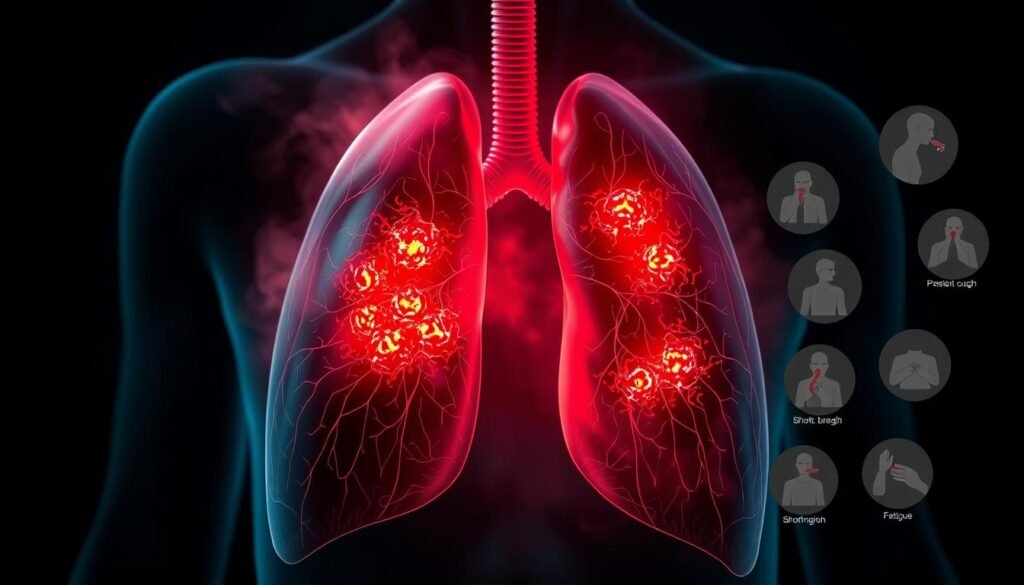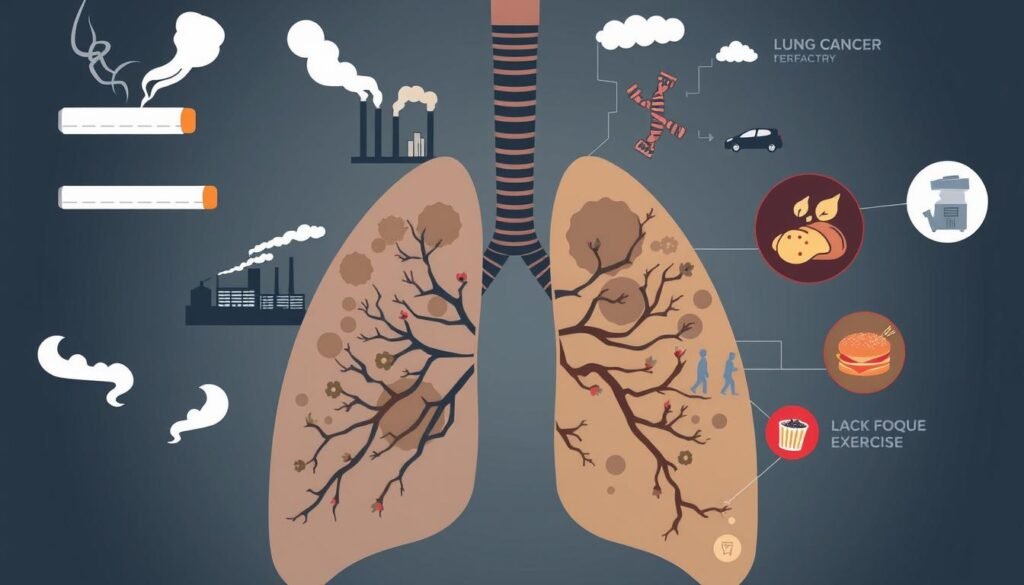A large number of lung cancer deaths in the U.S., about 80% to 90%, are due to smoking. This fact emphasizes the importance of knowing about lung cancer. It points out why we need to understand its types, risk factors, and signs. Smokers have a 15 to 30 times greater risk of getting lung cancer than non-smokers. This shows how crucial it is to spot the disease early.
Lung cancer leads to more deaths worldwide than any other cancer. It includes types like Non-Small Cell Lung Cancer (NSCLC) and Small Cell Lung Cancer (SCLC). Recognizing symptoms such as a lasting cough and chest pain is vital for early detection. Besides smoking, being around radon, asbestos, and certain jobs can raise lung cancer risk. For detailed symptom information, check this guide. Knowing these factors helps in early disease spotting, which aids in its prevention and timely treatment.
Key Takeaways
- 80% to 90% of lung cancer deaths are linked to cigarette smoking.
- Smokers are 15 to 30 times more likely to develop lung cancer compared to non-smokers.
- Common lung cancer types include Non-Small Cell Lung Cancer and Small Cell Lung Cancer.
- Key symptoms to watch for are persistent cough, chest pain, and weight loss.
- Risk factors include radon exposure, asbestos, and smoking.
- Lung cancer is the leading cause of cancer deaths globally.
- Early detection can significantly impact treatment success and outcomes.
Understanding Lung Cancer
Lung cancer is the third most common cancer in the United States. It follows breast and prostate cancer. Every year, about 235,000 new cases are found, and 611,000 people live with it across the country. Smoking causes nearly 90% of lung cancer cases. Interestingly, 60% of lung cancers are found in people who have stopped smoking. This shows the lasting dangers of using tobacco.
An important part of knowing about lung cancer is seeing how it affects lung health. Symptoms might not show until the cancer is far along. They include ongoing coughing, chest pain, and losing weight without trying. These signs can be mistaken for less serious problems. Knowing these symptoms is key for catching the cancer early. When caught early, over 90% of patients can survive.
For a deeper look at lung cancer, exploring cancer definitions, risk factors, and staging is very helpful. About 85% to 90% of lung cancers are non-small cell. The other 10% to 15% are small cell. Understanding the types and how common they are helps spot risks and symptoms sooner.
Types of Lung Cancer
Lung cancer is a complex disease. It’s broadly classified into two main types: non-small cell lung cancer (NSCLC) and small cell lung cancer (SCLC). NSCLC makes up about 80 to 85% of cases, making it the most common type. This lung cancer classification helps doctors choose the best treatment for each subtype.
There are several subtypes of NSCLC, including:
- Adenocarcinoma: This type starts in mucus-producing gland cells, usually in the lung’s outer parts.
- Squamous Cell Carcinoma: Found near the center of the lung by an air tube, this cancer develops in cells lining the airways.
- Large Cell Carcinoma: Known for larger cancer cells, this subtype grows and spreads faster than others.
Other rare lung cancer types are adenosquamous carcinoma and sarcomatoid carcinoma. Mesothelioma, another rare cancer, affects the lung covering. Pancoast tumors, different still, start at the lung’s top.
Small cell lung cancer is about 15 to 20% of all lung cancer cases. It’s strongly tied to cigarette smoking. This cancer type grows fast and often spreads to other parts of the body.
Knowing the different lung cancer types helps doctors aim for the best treatment. This approach aims to improve how patients fare.
Most Common Lung Cancer Types
Learning about the main types of lung cancer is key for proper diagnosis and treatment. Non-small cell lung cancer is the most common type, making up 80% to 85% of cases in the U.S. It includes different subtypes, each having unique features.
Non-Small Cell Lung Cancer
Non-small cell lung cancer is the most common within lung cancer cases. It has three main subtypes: adenocarcinoma, squamous cell carcinoma, and large cell carcinoma. Adenocarcinoma is the top subtype, found in 40% to 50% of cases. It mostly affects non-smokers and is the most common in women.
Squamous cell carcinoma represents 20% to 30% of non-small cell lung cancer cases. Large cell carcinoma is seen in about 3% to 10% of people diagnosed. Each type requires a different approach for treatment.
Adenocarcinoma
Adenocarcinoma is mostly found in adults 35 and younger, making it the leading lung cancer subtype in this group. It’s more common in those who’ve never smoked. New treatments targeting specific genetic changes have improved care for these patients.
Squamous Cell Carcinoma
Squamous cell carcinoma often starts in the flat cells of the airways and is closely linked to smoking. Knowing the risks and signs of this cancer is critical for early treatment. This can make a big difference in fighting the disease.
Symptoms of Lung Cancer
Lung cancer signs may appear slowly and are hard to catch early on. Look for a cough that doesn’t go away after eight weeks, chest pain that gets worse when you move, and losing weight without trying. People might also feel very tired and have trouble breathing because the cancer makes it hard for air to pass through.
If you cough up blood or sputum that looks rust-colored, see a doctor right away. Getting checked early is key because it means better chances for successful treatment.
Lung cancer can also lead to other health issues, like:
- Hoarseness caused by a long-lasting cough or a tumor affecting the vocal cords.
- Frequent lung infections such as bronchitis and pneumonia.
- Pain in the bones if the cancer has spread there.
- Feeling weak or having numb arms or legs.
- Swelling in the face, neck, or arms caused by certain lung cancer-related syndromes.
Other symptoms to watch for include swelling in the face, headaches, and trouble breathing. These could be signs of superior vena cava (SVC) syndrome. Lung cancer might also lead to paraneoplastic syndromes, which can affect different parts of the body including the nerves and hormone levels, causing other health problems.

| Symptom | Description |
|---|---|
| Persistent Cough | A cough lasting longer than eight weeks. |
| Coughing Up Blood | Hemoptysis, or blood in sputum, even in small amounts. |
| Chest Pain | Discomfort that intensifies with certain actions. |
| Shortness of Breath | Difficulty breathing due to blockage in airways. |
| Weight Loss | Unexplained loss of appetite leading to weight reduction. |
| Fatigue | General tiredness and lack of energy. |
| Swollen Lymph Nodes | May indicate spread to lymphatic systems. |
Early recognition of lung cancer symptoms is crucial for better treatment results. Those who smoke or have smoked a lot in the past especially need to get routine checks. This way, they can manage their health better and catch any issues early.
Lung Cancer Stages
Understanding lung cancer stages is key to choosing the best treatment. It gives important details about the disease’s spread, which helps doctors make smart choices. Each stage describes different parts of the cancer journey and affects how it’s treated.
Stage 0: Carcinoma In Situ
This early stage shows abnormal cells in the lung lining. These cells haven’t spread. Because it’s found early, surgery often works well to treat it.
Stage I
Stage I means the cancer hasn’t spread to nearby lymph nodes. It’s still limited to one area. Stage 1A’s tumor size helps decide its exact type. Stage 1B has tumors bigger than 3 cm but not over 4 cm.
Stage II
By Stage II, the cancer might be larger and reach close lymph nodes. Stage 2B describes tumors up to 5 cm that have spread to certain lymph nodes. These details are crucial for choosing the right treatment.
Stage III
Stage III involves bigger tumors that spread to important lymph nodes. The size and spread of these tumors mean more complex treatments are often needed.
Stage IV
Stage IV is the most serious, with cancer spreading beyond the lungs. It’s split into Stages 4A and 4B, based on the spread’s scope. Treatments aim to ease symptoms, sometimes using chemotherapy, immunotherapy, or care focused on comfort.
Primary Risk Factors for Lung Cancer
Various risk factors largely shape the landscape of lung cancer. At the top of this list is smoking. It’s linked to about 90 percent of lung cancer cases. Smoking greatly increases the risk and is the main reason behind most lung cancer diagnoses.
Another important factor is family history. It plays a crucial role in lung cancer risk. If lung cancer runs in the family, the risk can double or even more. Knowing one’s family history is key for early detection and steps to prevent it.
Environmental factors also play a part in lung cancer risks. For example, being exposed to asbestos at work can lead to a lot of lung cancer cases. This is especially true for mesothelioma, with 70 to 80 percent of cases caused by such exposure. Also, radon exposure is behind about 30 percent of lung cancer deaths among non-smokers.

The combined impact of these lung cancer risk factors is huge. Smokers who also have a family history of lung cancer or are exposed to hazardous environments have a higher risk. It shows how important it is to be aware and monitor yourself if you might be at risk.
For more details on lung cancer risk factors, it’s best to talk to health experts. Staying informed about ways to keep your health in check is wise.
Smoking and Lung Cancer
Cigarette smoking is the top risk for lung cancer. About 80% of lung cancer deaths are due to smoking. Smokers are 15 to 30 times more likely to get lung cancer than non-smokers.
Impact of Cigarette Smoking
Smoking affects health beyond lung cancer. The harmful things in smoke change lung cells over time. Here are some important facts:
- Almost 90% of lung cancer risk in men comes from smoking.
- In women, smoking causes 70 to 80% of lung cancers.
- Some smokers, like those taking beta-carotene supplements, are more at risk.
Secondhand Smoke Exposure
Being around smoke can also cause lung cancer. It’s the third biggest cause in the US. Being exposed at home or work raises your risk. Here’s why it matters:
- Even non-smokers can get lung cancer from secondhand smoke. This shows why smoke-free places are needed.
- Every year, over a million deaths globally are from lung cancer due to smoking and secondhand smoke.
Knowing the risks of smoking and secondhand smoke is key. It helps people make better choices for their health and for others.
Environmental Risk Factors
Environmental risks play a big part in lung cancer. This is true for smokers and non-smokers. Knowing these risks helps with prevention and finding the disease early.
Radon Exposure
Radon is a major cause of lung cancer in the U.S. It leads to around 21,000 deaths yearly from lung cancer. This gas comes from the natural breakdown of uranium in the ground. It can build up in homes, especially basements.
It’s a hidden danger to people living there. Testing your home for radon is a key step to take. This helps lower the environmental risk.
Air Pollution
Air pollution is a big factor in lung cancer risk. This is more so in cities where harmful particles are found. These come from diesel exhaust, power plants, and wood burning.
These pollutants can make lung cancer more likely. It’s a concern for people living in areas with poor air quality.
Asbestos Exposure
Asbestos is still a dangerous environmental risk. This is especially true in workplaces. Breathing in asbestos fibers can cause major lung disease, including lung cancer, more so in smokers.
There are rules to reduce asbestos use. But older buildings can still have asbestos. Being aware and taking safety steps are key to handle this threat.

Occupational Exposures and Lung Cancer
Jobs can play a big role in causing lung cancer. Many workers come into contact with dangerous substances. These include asbestos, arsenic, and diesel exhaust, which are major culprits.
People working in construction and shipbuilding are especially at risk. These jobs often expose workers to cancer-causing agents. It’s important to know about these dangers at work. Smoking can make this risk even worse.
About 10% of lung cancers are due to workplace dangers. Diesel fumes can increase the risk, even in small amounts. Silica dust is also a big problem, risking the health of millions worldwide.
| Occupational Carcinogens | Industries Affected | Potential Lung Cancer Risk |
|---|---|---|
| Asbestos | Construction, Shipbuilding | Increased susceptibility |
| Arsenic | Mining, Agriculture | Heightened risk |
| Diesel Exhaust | Transportation, Construction | Low-level exposure risk |
| Silica | Mining, Manufacturing | Significant health concern |
Keeping a safe workplace can lower these dangers. Using good safety practices can help a lot. Knowing the risks and taking steps to avoid them is key.
Lung Cancer Treatment Options
Lung cancer treatment combines different methods. Each method is chosen based on the patient’s needs. Knowing your options helps you make better decisions.
Surgery
Surgery is key for treating early lung cancer. Different surgeries are used depending on the cancer’s size and where it’s located. About half of these surgeries use a method called thoracotomy. This lets doctors fully access the lungs.
Finding cancer early through screening makes surgery more successful. It can greatly improve results for the patient.
Radiation Therapy
Radiation therapy is important, especially for late-stage lung cancer. It targets tumors with external beam radiation. Doctors often combine it with other treatments for better results. The main goals are shrinking the tumor or easing symptoms. Researchers are always looking for safer, more effective methods.
Chemotherapy and Targeted Therapy
Chemotherapy uses drug groups via IV to attack fast-growing cancer cells. Tests for genetic changes can help tailor treatment for non-small cell lung cancer. Targeted therapies offer options for certain tumors. These include crizotinib, erlotinib, and cetuximab. Scientists are testing new treatments to improve care.
Alternative treatments like acupuncture might improve well-being when used with traditional methods. For more on lung cancer and respiratory allergies, visit this resource.
| Treatment Type | Primary Use | Administration Method |
|---|---|---|
| Surgery | Early-stage lung cancer | Various surgical techniques |
| Radiation Therapy | Advanced lung cancer | External beam |
| Chemotherapy | Aggressive lung cancers | IV infusion |
| Targeted Therapy | Specific mutations | Pills or IV |
Lung Cancer Survival Rates
Lung cancer survival rates change a lot depending on when the cancer is found. If caught at Stage I, the survival rate is nearly 65%. This shows why finding cancer early is key to a better outcome. When cancer moves to Stage II, the survival rate falls to about 40%. By Stage III, only about 15% survive.
Stage IV lung cancer has a tough outlook, with a survival rate of around 5%. These numbers show how crucial early detection is. The prognosis may change based on the lung cancer type. Non-small cell lung cancer (NSCLC) makes up about 90% of cases. It has better early-stage survival rates of about 60%. Meanwhile, small cell lung cancer (SCLC) is more aggressive, with a 29% early-stage survival rate.
Across all types, the overall 5-year lung cancer survival rate is 19%. Younger patients generally have better outcomes than older ones. With new treatments being researched, there’s hope for improving survival rates for everyone.
Conclusion
Lung cancer is a major health issue, leading in cancer deaths worldwide. Knowing about the different types, symptoms, risk factors, and how to treat lung cancer is key. Most lung cancer, about 85%, is caused by smoking. This means fighting smoking is critical to lower lung cancer rates.
Also, knowing about harmful environments helps in preventing lung cancer. Screening people at high risk and using good diagnostic tools can catch cancer early. This can make a big difference in survival. Surgery, chemo, and new treatments bring hope. Being part of clinical studies can give access to new treatments.
Better education, preventing lung cancer, and improving treatments are all important steps for health experts and everyone. We must keep working on stopping smoking, reducing risks, and better screening to fight lung cancer. By focusing on these areas, we aim to lessen the impact of lung cancer for the people of tomorrow.